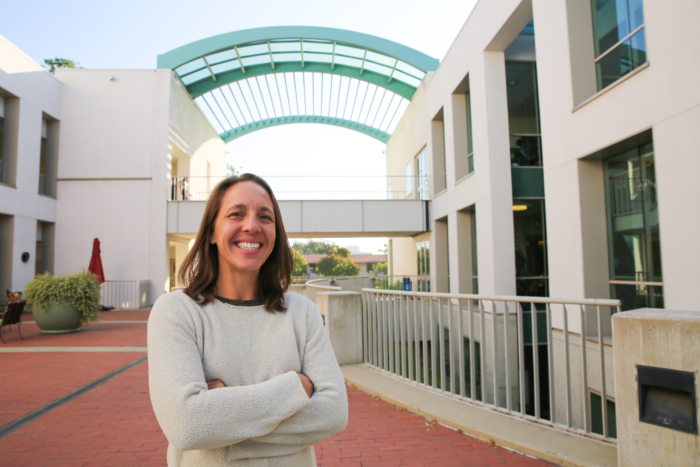
This fall, 11 new tenure-track faculty members joined Scripps College, including two at the W.M. Keck Science Department. As part of our ongoing series on Scripps’ faculty, the Office of Marketing and Communications recently sat down with Jenna Monroy, who joins the College as assistant professor of biology.
Monroy earned her BSc degree at the University of Massachusetts, Amherst, and her PhD at Northern Arizona University. Her research integrates muscle physiology, biomechanics, and neurobiology to study the control of movement. Specifically, her work investigates how muscles function not only as motors but also as springs, brakes, and struts. Her recent work on the role of the elastic protein titin in active muscle has expanded traditional theories and fills in gaps in our understanding of muscle function. Through a continuing collaboration with biologists, chemists, and engineers at the Center for Bioengineering Innovation at Northern Arizona University, Monroy’s lab contributes to the development of a muscle model that predicts how titin contributes to active muscle function.
Scripps College: “Springiness” in muscles is kind of intriguing as a conversation starter! If you were to introduce your research interests to non-scientists you met at a social gathering, what would you tell them?
Jenna Monroy: Well, a place to start might be to look at the prey-capture behavior in frogs, a model I’ve used in my lab that incorporates techniques and concepts from biology, physics, and chemistry to study the control of movement. If you think about how frogs stick out their tongues to catch a bug, you know they do it really, really fast. When they activate their jaw muscles, elastic energy is stored and recovered at the onset of tongue projection to amplify the power of the movement. Tongue projection is a combination of sensory, mechanical, and neuromuscular factors similar to how grasshoppers “load a spring” in their crouching position before jumping. In my lab, we attempt to create good predictive models that describe the force of a muscle during movement—current models can’t predict muscle force during dynamic movement. By studying the unique properties of muscles, we can better understand and predict the neural control of movement.
SC: So how is the feeding mechanism in frogs related to amputee prosthetics?
JM: Using in vitro muscle physiology and molecular biology, our lab characterizes the spring properties of muscles. It is because of these properties that muscles in our bodies are able to adapt instantaneously to changes in load without sensory feedback. These properties at least in part keep us upright when we trip over a rock or slip on some ice. In collaboration with Kiisa Nishikawa and the Center for Bioengineering Innovation at NAU, our data on muscle properties has been used to develop control algorithms for lower limb prosthetics.
Our works tests the novel winding filament hypothesis (WFH), which builds our current knowledge of muscle contraction by incorporating a role for the elastic protein, titin. The WFH explains how titin contributes to active muscle stiffness. Our collaborators at NAU implemented a control algorithm based on the WFH into the Biological Observation Matrix (BiOM) prosthetic and tested subjects under a variety of conditions, including level walking, stair ascent/descent, ramps, backwards walking, and uneven terrain.
SC: What can your Scripps students look forward to in their classes and in your lab?
JM: We take an integrated approach to understanding how an organism moves: at all levels of physiology from the whole organism down to the interaction of individual molecules. I draw upon concepts and methods from biology, chemistry, and physics to study movement in a variety of animal species from frogs to humans. There are many ways my research can be applied, in areas such as human health, as in the prosthetics project, or understanding titin function implications in muscular dystrophy. As part of my NSF grant, I will recruit Scripps students to conduct research in my lab and at the Center for Bioengineering Innovation at NAU.
SC: Is there a fact about yourself that is surprising, or that people don’t know about, that you’d like to share?
JM: Two of my favorite things: dogs and soccer. I would love the opportunity to teach the physiology of dogs and the biomechanics of sports. Who wouldn’t want to use a high-speed camera to capture a dog racing after a tennis ball or a soccer player taking a PK?

